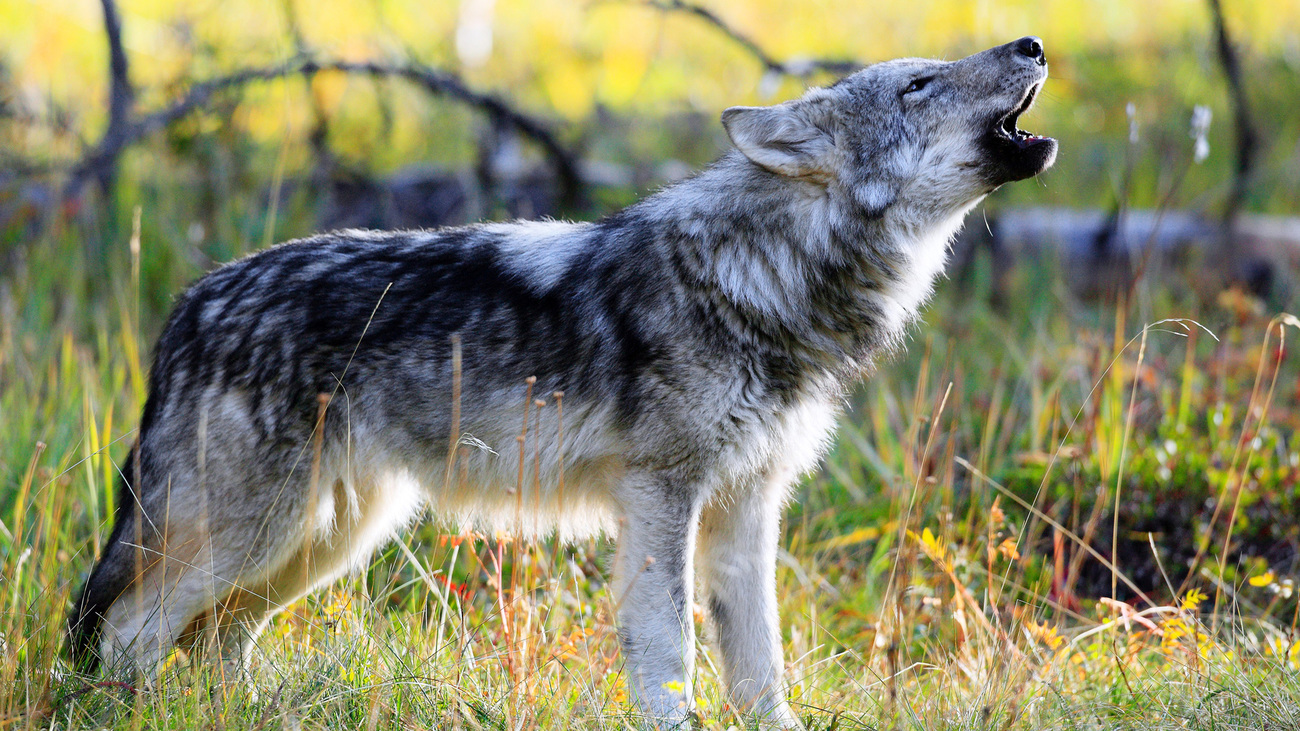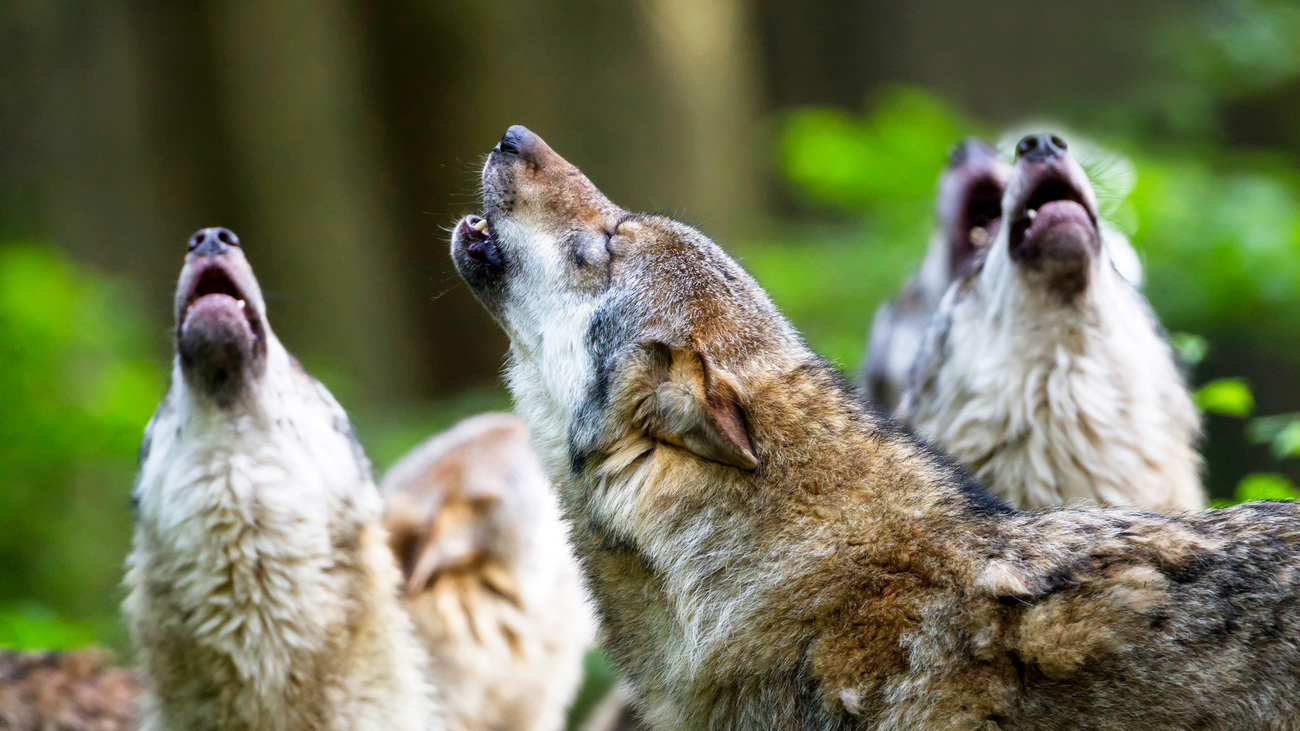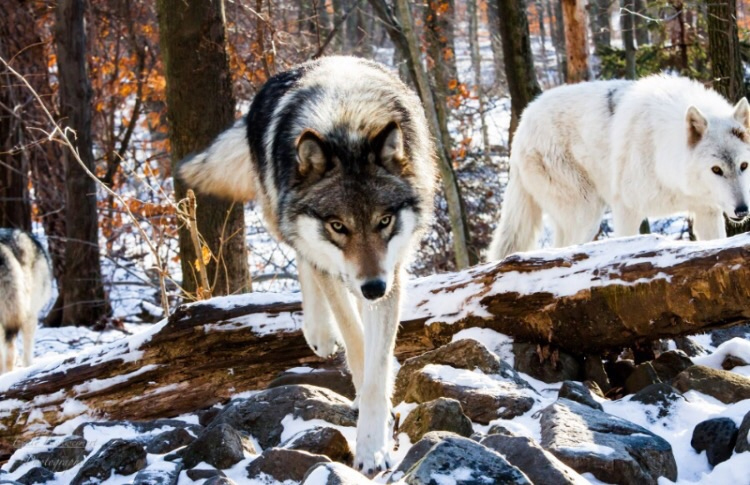Predator Coexistence - United States
Coexistence is a better existence for allFacts and FAQ about wolves
Facts and FAQ about wolves
For centuries, wolves have captured our imaginations. Some cultures consider wolves to be important symbols of power or protection, while others make them out to be menacing villains—think Little Red Riding Hood and The Three Little Pigs.
In real life, wolves pose surprisingly little danger to humans, whereas they are the targets of government-sponsored killing in many countries across the globe.
Here are the answers to the most common questions we hear about these misunderstood animals.

Where do wolves live?
Wolves can be found throughout the Northern Hemisphere. In North America, they are widespread across Canada and can also be found in some US states, including Alaska, Michigan, Wisconsin, Idaho, Oregon, Montana, and Wyoming.
A wolf population of only about 20 lives in California, and their populations in Oregon and Washington are also very small, each fewer than 200. These are members of the Northwestern grey wolf subspecies (Canis lupus occidentalis). The Northwestern grey wolf populations in Idaho, Montana, and Wyoming are slightly larger, estimated at about 1,556, 900, and 327 respectively. The Northwestern grey wolf population in Alaska is the largest, at 7,000-10,000. Alaska also holds the only population of the Alexander Archipelago wolf (Canis lupus ligoni).
There are small populations of the Mexican grey wolf subspecies (Canis lupus baileyi) living in Arizona and New Mexico, about 72 and 114 wolves respectively.
The Great Plains wolf subspecies (Canis lupus nubilus) is found in Minnesota, Michigan, and Wisconsin. The Eastern wolf (Canis lupus lycaon) is also found in this region.
There are also wolves present in North Carolina, but these are red wolves (Canis rufus), not grey wolves. The red wolf species is critically endangered, as there are only about 20 of them remaining in the wild. They are some of the most endangered mammals in the world.
Canada is home to the second-largest wolf population in the world—over 50,000 grey wolves. Here are all the wolf subspecies native to Canada:
- Arctic wolf (Canis lupus arctos), found on Melville Island and Ellesmere Island
- British Columbian wolf (Canis lupus columbianus), found in coastal British Columbia and Yukon
- Vancouver Island wolf (Canis lupus crassodon), found on Vancouver Island and in British Columbia
- Eastern wolf (Canis lupus lycaon), found in Ontario, Quebec, and Manitoba
- Mackenzie River wolf (Canis lupus mackenzii), found in the Northwest Territories
- Northwestern wolf (Canis lupus occidentalis), found in Yukon, Northwest Territories, British Columbia, Alberta, and Saskatchewan
- Great Plains wolf (Canis lupus nubilus), found across much of Canada, the US, and Greenland
Across the ocean, Russia hosts the world’s largest wolf population at about 300,000.
In Asia, wolves have large, stable populations in Kazakhstan, Kyrgyzstan, and Mongolia. China, India, Iran, Turkey, Uzbekistan, Tajikistan, and Turkmenistan also all have wolf populations estimated to be in the thousands. Wolves can be found in smaller numbers in Saudi Arabia, Pakistan, Syria, Jordan, Iraq, Lebanon, and Nepal. Nepal’s wolf population is one of the smallest, estimated to be only about 10.
Wolves live in several European countries, too. Here are the latest numbers from the EU on each country’s wolf population.
- Italy: 3,307
- Romania: 2,500-3,000
- Bulgaria: 2,712
- Spain: more than 2,100
- Poland: 1,886
- Germany: 1,404
- France: 1,104
- Greece: 1,020
- Lithuania: 728
- Latvia: 700
- Slovakia: 400-600
- Sweden: 450
- Estonia: 300-330
- Finland: 310
- Portugal: 300
- Croatia: 243
- Czechia: 120-150
- Slovenia: 116
- Austria: 70-80
- Hungary: 60-70
- Netherlands: 63
- Denmark: more than 30
- Belgium: 28
- Luxembourg: 0-2
In 2023, every one of these European countries reported stable or increasing wolf populations.
A variety of wolf subspecies appear in Europe and Asia:
- The tundra wolf (Canis lupus albus) lives in the far north of Russia
- The Arabian wolf (Canis lupus arabs) lives in the Middle East
- The steppe wolf (Canis lupus campestris) is found in Eastern Europe, the Caucasus, and Central Asia.
- The Himalayan wolf (Canis lupus filchneri) lives in the Himalayas and the Tibetan Plateau.
- The Mongolian wolf (Canis lupus chanco) is found in Mongolia, China, and eastern Russia.
- The Italian wolf (Canis lupus italicus) is found in the Italian Peninsula and parts of Western Europe.
- The Eurasian wolf (Canis lupus lupus) lives across Eastern Europe, Northern Europe, Russia, China, and Mongolia.
- The Indian wolf (Canis lupus pallipes) is found in Turkey, the Middle East, Iran, Pakistan, and India.
- The Iberian wolf (Canis lupus signatus) is found in parts of Portugal and Spain.Wolves make homes in forests, deserts, grasslands and everything in between, including developed environments such as agricultural land.

How long do wolves live?
In captivity, a wolf can live up to 15 years. In the wild, a wolf’s lifespan is usually about 5-7 years.
What do wolves eat?
Wolves are true carnivores and eat 1.4–1.8 kilograms (3–4 pounds) of meat per day. At times, they can consume as much as 4.5 kilograms (10 pounds) of meat in a single day.
Wolves primarily hunt ungulates, such as deer, roe deer, wild boar and moose. Sometimes, depending on their habitat, they may also eat rabbits, birds, fish, and amphibians. Because wolves hunt in packs, they can take on animals that are larger than themselves, but they still often seek out the smallest and weakest animals.
Why do wolves howl?
Howling is an important way for wolves to communicate. Wolves howl to keep the pack together during a hunt, to signal when they have spotted prey, or to attract a mate. Wolves also howl to mark their territory and scare off other wolves.
Each wolf howls at its own unique pitch, which helps them determine how many animals are in another pack. Within a pack, wolves can recognize each other by their howls.
Howling is not the only way wolves communicate. They use other sounds, scents, and body language to convey a variety of messages to other wolves.
Where do wolves sleep?
Wolves rest and slumber in the grass, under trees, or in bushes. As a female wolf prepares to give birth, her pack moves into a den, which is often dug near water and sometimes lasts for several generations. The female wolf gives birth to her cubs and cares for them in the den, guarded by the father, until they are strong enough to travel with the pack.
How big is a wolf pack?
A pack is composed of a wolf family led by parents, often with two generations of cubs below them. A female wolf gives birth to an average of one to eight cubs, but not all of them survive their first year. In Europe, packs do not normally exceed two to 10 wolves. In North America, wolves may have larger packs of up to 20.

How far do wolves travel?
Female wolves tend to remain closer to the pack, while male wolves often set out in search of new habitat and a mate. Such a journey is easily hundreds of kilometers long.
Wolves in Russia and Finland have been tracked migrating all the way to Norway and Sweden—a distance of 1,000 kilometers (620 miles)!
Are wolves dangerous to humans?
Wolves pose very little risk to human safety in Europe and North America. Researchers have noted that although the statistical risk of a human being attacked by a wolf is above zero, it is far too low to be calculated. In fact, wolves are probably more afraid of you than you are of them—they tend to flee when a human is present. Occasional close encounters between humans and wolves that typically result from habituation—when wolves become accustomed to humans and no longer fear them—are likely to have fatal consequences for the wolves.
Humans and wolves can easily coexist. If we leave wolves alone, they will leave us alone.
How is IFAW helping wolves?
In Canada, wolves are trapped and killed for recreational and commercial purposes. They are also the target of government-led slaughters in British Columbia, Alberta, and the Northwest Territories.
In parts of Canada and the US, deadly poisons—which threaten non-target wildlife, pets and even people—are also used to kill wolves in a misguided effort to reverse the decline of endangered caribou population.
In both Canada and the US, IFAW is supporting legislation and regulations that would stop the use of the poisons such as sodium cyanide, strychnine, and Compound 1080 to kill wolves and other species. The use of these poisons is inhumane and unethical, as they cause intense suffering and a prolonged, painful death. They are also ecologically disruptive and dangerous to the public. Recently, Canada announced that it will no longer use the chemical strychnine to kill wolves, thanks to the advocacy of conservationists.
By contrast, wolves are strictly protected in the EU, and packs have started to repopulate certain parts of their historic range. IFAW was a part of a joint letter addressed to the European Commission regarding their proposal to lower the protection status of wolves in Europe, urging its rejection.
In the US, wolves were reintroduced into the lower 48 states in the 1990s after being wiped out during the preceding century. They have since reprised their role as an integral part of their ecosystems, including the landscapes in and around Yellowstone National Park.
Populations in North America and Europe require ongoing protection before they—and the ecological services that they provide—are truly sustainable.
Related content
every problem has a solution, every solution needs support.
The problems we face are urgent, complicated, and resistant to change. Real solutions demand creativity, hard work, and involvement from people like you.